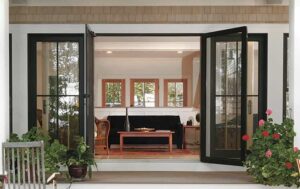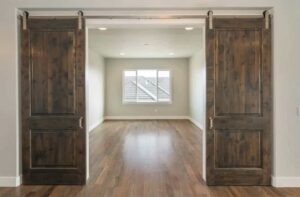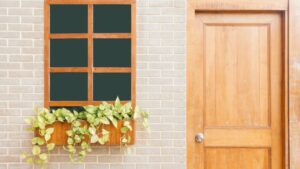Overview of Hidden Doors
When you consider your interior design, the hidden doors or secret doors may let you picture something out of a mystery novel or a superhero movie. In reality, these concealed passages are super cool, practical features that can add a bit of whimsy or extra security to your home. Imagine pressing a book on a shelf and watching a hidden door swing open to reveal a secret hidden room that could be your very own hidden home office or a cozy reading nook.
There are two main types of hidden doors: the jib door and the Pivot door.
Jib doors, are designed to seamlessly blend into walls, ceilings, or other surfaces. They utilize concealed hinges and hardware so that the door lies completely flush with the surrounding surface when closed. However, make sure there is enough room to open and close. This creates the illusion of a solid wall rather than an entryway. Jib doors are often customized with matching finishes, patterns, or murals so they visually disappear into the decor.
Pivot doors are doors that pivot open on a central axis point, usually along the center of one of the vertical edges. They can be disguised behind or built into cabinets, mirrors, bookcases, or other fixtures. When the fixture is pivoted open, it reveals the hidden room or passageway behind it. Pivot doors are another way to discretely access concealed spaces, providing a touch of intrigue.
Here’s a quick list of a few hidden doors most commonly found in homes:
- Bookcase Doors: Classic and clever, these make use of the bookcase facade to conceal a room.
- Wall Panel Doors: Blends seamlessly with the room’s design. It’s like a part of the wall just opens up.
- Cabinet Doors: Perfect for kitchens or dens, these doors look like ordinary cabinets but lead to another space.
- Mirror or Artwork Doors: Who would think that your reflection or that beautiful painting swings open to a hidden space?
Typically, hidden doors have certain shared features:
- Concealed Hinges: They’re essential for maintaining the illusion.
- Matching Design: Whether it’s woodwork or paint, the door matches the surrounding walls.
- No Visible Door Frame: To keep things stealthy, the frame is absent or disguised.
Don’t think you’re settling for just a cool factor; these secret doors can also help your spaces stay tidy by hiding a utility closet or providing a surprise storage area. So if you’re tight on space or just want to add a touch of mystery to your abode, consider the charm of a hidden or concealed door that opens up to your own secret room. It’s functional, it’s fun, and honestly, it never gets old pushing that book or tilting that statue to sneak into your secret hideaway. Follow this article and find the best hidden door idea for your own home.
Design and Installation
When installing a hidden door, the devil’s in the details. Your selection between bookshelf and cabinet doors versus wall and jib doors will largely depend on your space availability, desired concealment level, and intended use. Remember, precision in measurements and a keen eye on the finish will ensure your secret passageway remains a well-kept secret.
Bookshelf and Cabinet Doors
Bookshelf doors, often referred to as Murphy doors, are classic hideaways that can hold your favorite reads while concealing a room or storage space. Measurements are crucial; you’ll need the height, width, and depth of your door frame as well as the space for the latch mechanism. Here’s a quick checklist:
- Ensure the bookcase is sturdy enough to handle regular use.
- Adjust shelving to distribute weight evenly.
- Concealed hinges are vital to maintain the illusion.
- The door should sit flush with the wall when closed.
Cabinet doors work similarly, often nestled within cabinetry for a seamless look. For these, plywood can be an economical and easy-to-work-with material for the door construction.
Wall and Jib Doors
Jib doors are the ninjas of the hidden door world, blending into wall paneling without a whisper of their presence. These doors match the wall so well that they’re virtually undetectable when closed.
- Use the same material as the surrounding walls for the door.
- Recessed pulls or magnetic touch latches can keep the door looking smooth.
- Flush finishes ensure that the jib door is invisible when not in use.
Jib and panel doors require meticulous carpentry to maintain the illusion. The goal is to make the door indistinguishable from the rest of the wall, so be deliberate with finishing touches like paint or wallpaper.
Types by Room and Usage

Choosing the right type of hidden door hinges heavily on which room you’re dealing with and what you’re using the space for. You want it to blend seamlessly with your environment while serving its purpose.
Entry to Personal Spaces
Your personal spaces are your retreats for relaxation or hobbies. Imagine opening a bookshelf in your hallway to slip into your home office, where you can work undisturbed. Or say you need some me time; a hidden door in your living room’s wainscoting could lead to a cozy man cave or a calming private room for yoga and meditation.
- Home Office: Concealed behind a bookcase or faux wall panel.
- Man Cave/Playroom: Accessed through a disguised doorway, like a mirrored section or a section of the wall that rotates inwards.
Access to Storage and Utility Rooms
Functionality meets clever design when it comes to hidden doors for storage and utility rooms. You might not want your laundry room or pantry visible from the main areas, so a door masquerading as a kitchen cabinet keeps things sleek. For more protection, a safe room or wine cellar could be behind a door camouflaged in the floor tiles or a seemingly decorative wall piece.
- Pantry/Laundry Room: Disguised as part of the kitchen cabinets or wall.
- Safe Room/Wine Cellar: Camouflaged ground panel or a part of a stone wall facade.
Decorative Elements and Finish
When you’re planning your hidden door, the devil is in the details. Think about these elements to maintain the stealthy chic of your space.
Wainscoting and Paneling Details
Your hidden door can cleverly masquerade as part of the room’s architecture with wainscoting or panel details. Imagine a door that’s indistinguishable from the rest of the wall because it features the same decorative trim and paneling – that’s the kind of seamless design you’re aiming for. You can position the door within the wainscot areas or use extended panels that fit within the broader wall design to disguise its location.
- Matching woodwork: Ensure that your door’s woodwork matches the surrounding area.
- Attention to detail: Align the patterns and grooves perfectly to avoid giving away the door’s location.
Door Finishes and Wallpaper Integration
Finishes and wallpaper can make or break the illusion of your hidden door. Choose finishes that match the room’s aesthetic, whether you’re going for a paint color that flows with the walls or a stain that complements your wood features.
- Paint: Pick a shade identical to the walls to blend the door seamlessly.
- Wallpaper: If you have wallpaper, the door must continue the pattern without interruption.
When using wallpaper, you especially have to be precise. Any misalignment could be a dead giveaway. Place the door in an area where the wallpaper pattern naturally lends itself to a break, like around corners or near architectural features, to enhance the illusion.
How to DIY Hidden Door Projects

Do you have a knack for a little home innovation and want to add a secret spot to your living space? DIY hidden door projects are right up your alley! It’s like your personal touch of a mystery novel right at home. Whether you’re looking to hide a private study or stash your treasures, let’s roll up those sleeves and dive in.
Basic Bookcase Hideaway
You can transform a standard bookcase into a swinging door by securing it with door hinges. This classic method means your collection of books becomes an unsuspecting door to whatever lies behind. Here’s what you need:
- A bookcase that fits the space
- Heavy-duty hinges
- A latch system
Sneaky Storage Panel
To pull this off, pick a wall section and install a small, inconspicuous door that blends seamlessly.
Essentials for this project:
- Wall cutout
- Hidden door hinges for a flush finish
- Magnetic touch latch
Double Door Deception
Yeah, you heard it right – double doors! If you’re feeling fancy and have the space, why not? Each door swings open to different areas; think of a home office on one side and a hidden lounge on the other.
Materials to gather:
- Two sets of doors
- Strong, concealed hinges
- Matching trim to disguise the seam
Upkeep Tip: Don’t forget to maintain your hidden doors. Regular checks ensure they stay secret and function smoothly.
In conclusion, there are two main types of hidden doors – jib doors and pivot doors.
Jib doors are flush with the wall and have concealed hinges, creating a seamless entryway that is not easily noticeable. Pivot doors are often disguised as or hidden behind cabinets, bookcases, mirrors or other fixtures. They pivot open to reveal a hidden room or passageway.
Hidden doors come in many sizes and configurations to suit different spaces and design needs. They can be customized with various finishes to better blend in. Key considerations when selecting a hidden door include size constraints, intended purpose, desired aesthetics, and ease of access.
Hidden doors allow for discreet access to secret spaces, providing intrigue and a touch of magic. They tap into childhood dreams of concealed rooms. With creative customization, they can be tailored to perfectly fit and disguise almost any entryway. The choice comes down to priorities around space, function and visual appeal.






